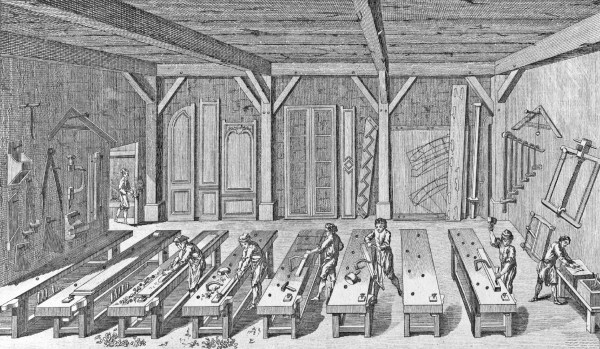
My job at Lost Art Press is basically this: wrangling content. I read it, edit it, listen to it, transcribe it, write it, find it, scan it, organize it, cut it, extrapolate it, link to it, contract it and share it. And through this wrangling, no matter the author or topic, universal themes emerge.
Often an 8-5 occupation, by nature of design, is one of repetition. And perhaps that’s part of the appeal of woodworking, both as an avocation and vocation—it requires constant learning, no matter the skill level. There’s always more to learn, new paths to take, ways to improve. There’s a scholarly aspect to it, and always the feeling of the possibility of a new discovery, with only the turn of the page or an afternoon at the bench.
And so I see the theme of lifelong learning emerge, over and over, from masters of the craft, in both written and vocal form.
In many ways it’s why Lost Art Press exists—as well as the many magazines, books, forums, guilds, classes, schools and DVDs that delve into the intricacies of woodworking.
There’s always more to know.
Here are some quotes, both formally written and in the form of snippets of conversation, that I’ve gathered during my more recent content wrangling from a few masters of the craft who still, to this day (or did, until they died) foster a love of learning.
“It’s interesting to speculate as to exactly when in one’s career one writes a book. I wrote ‘Welsh Stick Chairs’ three years ago, but I am still on the learning curve, and I’ve moved on. In theory, I suppose when one is 99, lying on the death bed, then you write about what you’ve learnt. No. I think the important thing to remember is that not all information in print is law, even if you don’t agree with what you read, it should stimulate thought.” —John Brown, Good Woodworking, 1994
“I’ve mainly been doing sculptures and some new chair stuff. I’ve had a great time and want to continue the ball rolling. I also want to further my chairmaking so when I get home I don’t feel I’ve done nothing in terms of my main craft. So I’ve pursued a couple different [ideas], and I’ll see how these things develop and hopefully [they’ll] become a part of what I do.” —Peter Galbert, on life as a resident artist, 2016
“I’ve often said, only sort of whimsically, if you had to distill down my job it would say, ‘Be productively curious.’ I was productively curious.” —Don Williams, on his almost three decades as Senior Furniture Conservator at the Smithsonian Institute, 2017
“For me, it’s really just keeping engaged, keeping really interested into what’s going on because we can never completely know it. And I hate and love that at the same time. I love being in the position of not knowing but maybe going to find out. And so it’s basically about keeping my eyes open and not taking myself too seriously, because nobody else does. And that’s really it. Not taking things personally in terms of interpreting the world as being against me or for me or any of that. I’m just here observing slowly, with my eyes as wide open as possible.” —Jim Tolpin, 2017
“Neither of us are trained designers, bur rather experienced builders with a healthy curiosity. We both began experimenting with the practices and suggestions laid out in the period design guides. We set aside tape measures and began using dividers. We opted to use geometry to trace layouts, even when precision tools were easier and more convenient. Our goals were to learn to see, and to discover if the tradition might reveal relevant information for today’s builder.” —George R. Walker, in his preface to “By Hand & Eye,” May 28, 2012
“There is a point where a craft becomes an art, and he can find enough to learn about woodwork as an art to last him for a lifetime.” —Charles H. Hayward, “Chips from the Chisel,” The Woodworker, 1936
— Kara Gebhart Uhl
Like this:
Like Loading...




















